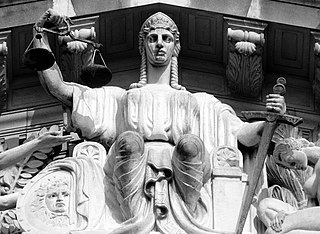Vexatious litigation is legal action which is brought solely to harass or subdue an adversary. It may take the form of a primary frivolous lawsuit or may be the repetitive, burdensome, and unwarranted filing of meritless motions in a matter which is otherwise a meritorious cause of action. Filing vexatious litigation is considered an abuse of the judicial process and may result in sanctions against the offender.
A Due Process Clause is found in both the Fifth and Fourteenth Amendments to the United States Constitution, which prohibit the deprivation of "life, liberty, or property" by the federal and state governments, respectively, without due process of law.
Native title is the designation given to the common law doctrine of Aboriginal title in Australia, which is the recognition by Australian law that Indigenous Australians have rights and interests to their land that derive from their traditional laws and customs. The concept recognises that in certain cases there was and is a continued beneficial legal interest in land held by Indigenous peoples which survived the acquisition of radical title to the land by the Crown at the time of sovereignty. Native title can co-exist with non-Aboriginal proprietary rights and in some cases different Aboriginal groups can exercise their native title over the same land.
Australian administrative law defines the extent of the powers and responsibilities held by administrative agencies of Australian governments. It is basically a common law system, with an increasing statutory overlay that has shifted its focus toward codified judicial review and to tribunals with extensive jurisdiction.
The Nurses and Midwives Tribunal is a former tribunal that was established in the Australian state of New South Wales which dealt with appeals and complaints of professional misconduct by nurses and midwives. The tribunal generally heard matters after the Nurses and Midwives Board has made a decision or a professional association had referred an issue to the tribunal. The tribunal heard matters in an informal manner in an attempt to do justice in the matter. The tribunal also conducted inquiries into complaints referred by the New South Wales Health Care Complaints Commission.

Plaintiff S157/2002 v Commonwealth, also known as 'S157', is a decision of the High Court of Australia.

The Arbitration Act 1996 is an Act of Parliament which regulates arbitration proceedings within the jurisdiction of England and Wales and Northern Ireland.

Roslyn Gay Atkinson is a former Justice of the Supreme Court of Queensland, who served for 20 years from 1998 until her retirement in 2018. In 2002 she also became the Chairperson of the Queensland Law Reform Commission, and served in that role until her retirement in 2013. As well as being responsible for the Yankee Doodles precedent, Justice Atkinson has also made two notable decisions in her capacity as member of the Queensland Legal Practice Tribunal.

Administrative law in Singapore is a branch of public law that is concerned with the control of governmental powers as exercised through its various administrative agencies. Administrative law requires administrators – ministers, civil servants and public authorities – to act fairly, reasonably and in accordance with the law. Singapore administrative law is largely based on English administrative law, which the nation inherited at independence in 1965.

Exclusion of judicial review has been attempted by the Parliament of Singapore to protect the exercise of executive power. Typically, this has been done though the insertion of finality or total ouster clauses into Acts of Parliament, or by wording powers conferred by Acts on decision-makers subjectively. Finality clauses are generally viewed restrictively by courts in the United Kingdom. The courts there have taken the view that such clauses are, subject to some exceptions, not effective in denying or restricting the extent to which the courts are able to exercise judicial review. In contrast, Singapore cases suggest that ouster clauses cannot prevent the High Court from exercising supervisory jurisdiction over the exercise of executive power where authorities have committed jurisdictional errors of law, but are effective against non-jurisdictional errors of law.

An ouster clause or privative clause is, in countries with common law legal systems, a clause or provision included in a piece of legislation by a legislative body to exclude judicial review of acts and decisions of the executive by stripping the courts of their supervisory judicial function. According to the doctrine of the separation of powers, one of the important functions of the judiciary is to keep the executive in check by ensuring that its acts comply with the law, including, where applicable, the constitution. Ouster clauses prevent courts from carrying out this function, but may be justified on the ground that they preserve the powers of the executive and promote the finality of its acts and decisions.

Minister for Immigration and Citizenship v SZMDS, is a landmark Australian judgment of the High Court. The matter related to immigration law, jurisdictional error and illogicality as a ground of judicial review.
Jurisdictional error is a concept in administrative law, particularly in the UK and Australia. Jurisdiction is the "authority to decide", and a jurisdictional error occurs when the extent of that authority is misconceived. Decisions affected by jurisdictional error can be quashed by judicial review. Examples of jurisdictional errors include asking a wrong question, ignoring relevant material, relying on irrelevant material, and breaching natural justice.

Briginshaw v Briginshaw (Briginshaw) is a decision of the High Court of Australia which considered how the requisite standard of proof should operate in civil proceedings.

MIEA v Guo, also known as 'Guo' is a decision of the High Court of Australia. The case is an important decision in Australian refugee law. The case has been described as setting out 'what is required for a decision-maker to have a "rational basis" for determining whether an applicant for refugee status has a well founded fear of persecution'.

Chen Shi Hai v MIMA, also known as 'Chen' is a decision of the High Court of Australia.

MIMA v Khawar is a decision of the High Court of Australia.

Minister for Immigration and Multicultural Affairs v Yusuf, also known as 'Yusuf', is a decision of the High Court of Australia.

Craig v South Australia is a decision of the High Court of Australia.

SZBEL v MIMA is a decision of the High Court of Australia.






